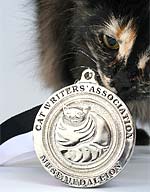 |
|||||||||||||||||||
|
|

We are the proud winners of the 2006 - 2009 winner of the Muse Medallion for Online Magazine by The Cat Writers? Association in their annual Communications Contest! (Photo courtesy of Weems Hutto).
On November 17, 2007 Felinexpress.com was honored to receive The President's Award by the Cat Writers' Association. We are very proud to have earned this distinction and will continue to provide quality information for all cat lovers.
Felinexpress.com Home > Cat Behavior > Living in a Multi-Cat Household |
Living in a Multi-Cat Household
In our household of over a dozen cats, the challenges of the group are met daily. Allowing these cats the freedom to roam our two-story home and their outdoor cat enclosure, means there is never a dull moment.
The strong alpha tendencies of the leaders, mixed with the meeker personalities of the group, makes for interesting living conditions inside the home. Over the years, certain processes have evolved, allowing the group to dwell together in greater harmony.
Feeding time
No free-feeding here. Dry cat food is placed out on several cookie sheets three times a day for a period of thirty minutes. The food is brought out at the same times every day. Once the thirty minutes is up, the food is removed.
Wet food is provided twice a day. Each cat has its own saucer. I line the saucers up on the floor, open several cans of quality wet food, dump that food into a large bowl, then spoon the food on the plates. This cuts down territorial disputes and food aggression during feeding time. After twenty minutes, the saucers are removed and washed. There is generally no food left at the end of twenty minutes. I found that feeding out of bowls increases food disputes. Cat’s whiskers are sensitive, anything bumping those whiskers can cause growling, stress and food fights.
If I see cats restless after feeding; not lying down or grooming or sleeping, then I know this cat missed out on his share. The cat(s) will be fed in another room shut off from the group until he/she has eaten his fill.
Water
The cats have pet fountains. We have one in each room (except the bathrooms). There is a free-flowing outdoor fountain in the cat enclosure. They have access to this enclosure twenty-four hours a day through tunnels that run out of our dining room window.
Flea-treating
Frontline and Advantage are the two products of choice. Once a month, while the cats are eating, they are also flea-treated. This has cut down tremendously on the stress the cats used to show during “flea treatment time.”
No more fighting, struggling, trying to hold on to a reluctant cat. No more drooling or strange behaviors. On flea treatment day, I feed the cats’ chopped mackerel (the smell of the fish overcomes the chemical smell of the flea medicine). Once each cat has a treatment, it is marked off the list of names.
Worming
A bit of a difficulty when it comes to a houseful of cats, but the outdoor enclosure I have found poses a danger for the cats to get tapeworms. Bad weather drives mice into the cat enclosure. I worm regularly with Drontal because all my cats have predatory natures. I know that if there are mice in the enclosure, they will not be alive long.
Trophies
Earthworms, butterflies, dragonflies, mice, even hummingbirds, can find their way into the enclosure usually ending up on our kitchen floor. Each cat is praised for his hunting prow prowess, no stress is shown about the recent kills, because this is what cats are. A well-fed cat is a hunting machine. Cats that are starving cannot hunt efficiently. Their offering is removed and they are fed a tasty, meaty treat. The trophy is then disposed of..
Aggression
Fights do break out occasionally between cats, especially when a new cat or kittens are brought in. Disputes are stopped in several ways; clapping hands will startle them apart, stamping feet also serves to break them up. Throwing a dark blanket or towel will also break up the skirmish.
Newcomers are isolated from the group for a period of time that varies anywhere from a week to an indefinite period of time. It is all indicative on the new cat and the tone of the group at the time. The newcomers are screened off from the other cats by specially constructed doors made of wood and chicken wire.
No catnip toys in the home. Catnip with cats that have lived outside tends to bring on aggressive behavior. Honeysuckle toys or valerian toys create calmer results.
No spray bottles of water. I have tested this type of “discipline” in the past, noticing almost immediately a change in the cat’s attitude toward me. It changes them, and not for the better!
Spaying and neutering is a must for cats. Cats not neutered or spayed will breed among themselves. Inbreeding can lead to all sorts of problems for you, the mom cat and the kittens. It also leads to fights among the males as they seek to dominate the females of the group. The males past puberty will also spray your home with odorous, noxious sexually charged urine.
Comfort Zone Room Diffusers by Farnum Pet, ™ another must for any multi-cat home. Several are going in our home at all times.
Feliway Spray is another essential tool to have around the house.
Pure Vanilla Extract is used when cats return from the vet. Generally, they bring with them alien scents, and stress pheromones. Applying the vanilla extract to three areas of all the cats in the house stops the hissing and growling. The three areas are: under the chin, between the shoulders, and the base of the tail.
Overcrowding
Providing spaces where the cats can get up and off the floor is imperative in a large group. Clearing off bookshelves, counters, the top of the refrigerator, or providing tall, sturdy cat posts, cat ramps or perches helps to quench territorial disputes.
Waste Disposal Stations
Ideally, you should have two litter boxes per cats. Some people can’t manage that, so you can compensate by ignoring the “standard” size litter pans and going to larger containers. Rubbermaid under-the-bed storage units are great- because you get two large litter pans. Drain pans for auto shops, small wading pools are other good options, if you have the space.
Multiple visits to these litter areas are essential for you as the owner to help monitor the health of your group. If you notice runny stool, or blood in the waste, a quick check of each cat’s rear will usually give you a clue as to who might be feeling poorly. Isolating that cat from the group to confirm your suspicions, and unless you have recently changed their diet, or your cat is allowed outside (which gets him into all sorts of food sources you have no clue about) a trip to the vet is wise.
Is taking care of a large group of cats challenging? Yes, at times it can be. But the rewards far outweigh the work involved. You will find that the cats who seek your attention will find that lap to sit on, or that hand to gently pet them. Others of the group who might be shy, or nervous will take time to bond with you. All the cats here have their claws. This means that at times, legs become scratched as cats take off while napping on a lap when a loud noise startles them. This is part of learning to live with these creatures, full acceptance of who they are, with no desire to change their natural behavior.
One of the biggest challenges for you as a caretaker is learning to say “NO” to yet another rescue. Understand your limits, both financially and emotionally. Understand too, that are so many cats out there in need of help. You cannot assist them all no matter how much you want to.
More cat breeds |
|
? Copyright 2006-2010 Felinexpress.com, All Rights Reserved
Privacy Statement - Disclaimer - About Me


